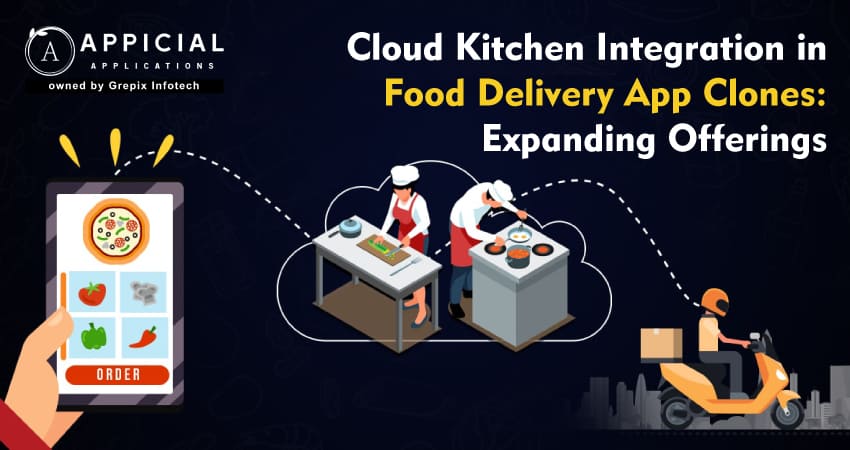
Cloud Kitchen Integration in Food Delivery App Clones: Expanding Offerings
Remember the days when food delivery meant pizza, Chinese, or maybe a burger if you were lucky?
Those days are long gone.
These days, with a few taps on your phone, you can summon anything from gourmet sushi to vegan BBQ, and it all happens behind the scenes, often in a kitchen you'll never see.
That’s the power of the cloud kitchen food app revolution.
And it's not just for the big guys anymore. Startups, small business owners, and even solo chefs are riding this wave, especially those diving into the world of food app clone cloud kitchen solutions.
This isn’t just another trend, it’s a full blown shift in how we cook, deliver, and consume food.
Let's dig into why cloud kitchens and virtual restaurants are flipping the script and how your app clone can cash in.
Cloud kitchens, or ghost kitchens, are changing the way we experience food delivery. This blog explores how cloud kitchen food app development is transforming the landscape for entrepreneurs and restaurateurs alike. From maximizing menu variety with virtual restaurant integration to seamless food app clone cloud kitchen implementation, we take a deep dive into how this growing trend is not just surviving but thriving in a competitive food tech world. Real-life case studies and strategic breakdowns included.
Overview of Cloud Kitchens
Before we get into the meat of things, let’s clear up the basics.
A cloud kitchen, also known as a ghost kitchen, dark kitchen, or virtual kitchen, is a cooking facility that produces meals for delivery only. No dining tables. No walk-ins. No storefront. Just chefs, recipes, and a relentless stream of delivery orders. These kitchens might house a single brand or several virtual brands all operating under one roof.
Now throw virtual restaurant integration into the mix, suddenly, you're not just managing one brand but possibly dozens, all from the same space. Think of it like Netflix, but for food. One platform. Infinite options.
But here’s the kicker, cloud kitchen food app developers are finding that pairing cloud kitchens with cloned versions of popular food delivery apps (like Uber Eats or DoorDash) lets them jumpstart their business without reinventing the wheel.
So instead of building a food empire from scratch, you’re essentially buying a proven system and plugging in an innovative, flexible backend. Neat, right?
Benefits of Food Delivery Apps
Now that we’ve laid the groundwork, let’s talk about why this pairing works like peanut butter and jelly. Or maybe like ramen and eggs. You get the idea.
1 Scalable Menu Offerings
With a cloud kitchen food app, you're no longer limited by physical space. Want to run a taco joint, a salad bar, and a Thai place—all from the same kitchen? Go for it. Each can be a separate virtual restaurant on your app. This lets food delivery apps cater to a broader customer base without massive overhead.
2 Lower Operational Costs
Running a brick-and-mortar restaurant comes with rent, utilities, decor, staff, and more. Cloud kitchens? Just rent your kitchen space and staff your cooks. When these kitchens plug into food app clone cloud kitchen platforms, you're reducing the cost for everyone while still charging premium prices for high-demand dishes.
3 Faster Market Testing
Ever wanted to test a new food concept without risking your brand’s reputation? Now you can. Launch a virtual brand in a cloud kitchen food app and see how it performs. If it flops, no one needs to know. If it flies, expand it across your app network.
4 Hyper-Local Reach
You can strategically place cloud kitchens in different parts of a city or region to reduce delivery times. By integrating with food app clone cloud kitchen tech, you can auto-assign orders based on proximity, making it faster and cheaper for customers to get their food hot and fresh.
5 Data-Driven Personalization
Here’s where it gets nerdy (and profitable). Every interaction within a cloud kitchen food app gives you data what’s popular, what time of day people order, where orders spike, and more. You can use this to tweak your virtual menus, optimize delivery logistics, and even create limited-time pop-ups based on trends.
What are the Implementation Strategies to Take Care of?
So, you’re sold on the idea. Great. But how do you get it done? Let's break down the steps for integrating cloud kitchens into your food delivery app clone.
Step 1 Choose the Right App Clone Base
First off, not all food delivery clones are made equal. Look for one that supports virtual restaurant integration natively. You'll want a backend that allows for multiple brands, flexible menu options, real time analytics, and geolocation mapping for smart delivery routing.
Think of your food app clone cloud kitchen as the control room. It should let you manage everything—from incoming orders to kitchen status updates with ease.
Step 2 Partner with or Build Cloud Kitchens
Next, you either partner with existing cloud kitchen operators or set up your own. Both options work, but your choice will depend on budget and control. If you’re new to the game, partnerships are safer. If you’re aiming for full stack control (and have the funds), building your facilities offers more customization.
Step 3 Integrate Kitchen Management Systems (KMS)
KMS is your kitchen’s brain. It links your virtual restaurants, handles order queuing, tracks inventory, and manages kitchen staff. It should also plug into your cloud kitchen food app and delivery systems so there are no bottlenecks.
Some popular KMS solutions include Toast, Square for Restaurants, and customized software integrations. Make sure your KMS plays nice with your app clone backend.
Step 4 Build a Strong Brand Strategy for Virtual Restaurants
Each brand within your kitchen needs its own identity menu design, pricing, photos, descriptions, even logos. Users shouldn’t feel like they're ordering from the same kitchen; they should feel like they’re browsing different restaurants.
Good virtual restaurant integration turns one kitchen into ten restaurants with different personalities. Lean into that.
Step 5 Optimize Logistics and Delivery
A smart delivery network is critical. Whether you integrate third-party services (like DoorDash or Uber Eats APIs) or run your fleet, orders need to move fast and smoothly.
Use real time GPS tracking and predictive route planning to ensure timely delivery. Consider using heat maps to position cloud kitchens in high-demand areas.
Step 6 Continuous Feedback Loop
Don’t just sit back once it’s live. Keep asking questions: Which menus are popular? Where are delays happening? What’s the customer satisfaction rating?
Tweak your app, test new brands, change menus, and rotate items. A good cloud kitchen food app thrives on experimentation.
Also Read: AI-Powered Chatbots in Food Delivery App Clones: Enhancing Customer Support
Case Studies: Dive into Real-Life Examples
1 Reef Technology Miami, FL
Reef took the concept of food app clone cloud kitchen one step further. They built modular kitchens inside parking lots yes, parking lots then used a cloned version of a multi brand delivery platform to offer everything from burgers to sushi in a single app.
They partnered with well known chains and local chefs alike, proving that real estate isn't necessary when data and demand drive location choice. With GPS-linked delivery, they reached customers faster than traditional restaurants.
2 Faasos (Rebel Foods) India
Rebel Foods is a textbook example of virtual restaurant integration. They run dozens of brands each with distinct identities through a centralized cloud kitchen network.
Their system is built to allow easy scaling, testing, and launching of new virtual brands based on customer data. Using their own cloned app platform, they’ve successfully expanded across multiple countries and continue to dominate the online food scene in India.
3 The Local Ghost Los Angeles, CA
A small time startup, The Local Ghost uses cloud kitchen food app technology to serve niche audiences, like vegan soul food, paleo breakfast, and late night Mexican fusion.
They used a clone of an existing app to keep costs low and focused entirely on digital marketing and influencer led campaigns. Despite being a tiny team, they quickly carved a name in the LA delivery scene.
Final Thoughts
Let’s face it food delivery isn't what it used to be. It’s faster, smarter, more personalized, and infinitely more competitive. To stand out, it's not enough to just have good food. You need tech to match.
Integrating cloud kitchen food app features into your delivery platform, especially through virtual restaurant integration, allows you to scale fast, diversify offerings, and tap into what consumers want: variety, convenience, and speed.
By using a food app clone cloud kitchen approach, you're skipping the slow crawl of traditional restaurant development and jumping straight into the fast lane of modern food tech.
If you're serious about launching your food delivery platform with cloud kitchen food app capabilities baked right in, Appicial Applications is worth a close look.
They specialize in robust, customizable food app clone cloud kitchen solutions that can be tailored to your exact needs, whether you're building a network of virtual restaurants or looking to scale an existing kitchen operation. With top-tier support, user-friendly UX, and smart backend integration, Appicial doesn't just hand you code, they help you build a business.
So, if you're ready to turn those food ideas into real revenue streams, visit Appicial Applications and give your food delivery venture the tech backbone it deserves.
Looking out to start your own venture like Zomato? Try out our MasalaDish Zomato Clone, the easiest way to kick-start your taxi business.Author's Bio

Vinay Jain is the Founder at Grepix Infotech and brings over 12 years of entrepreneurial experience. His focus revolves around software & business development and customer satisfaction.
Back to blog list




